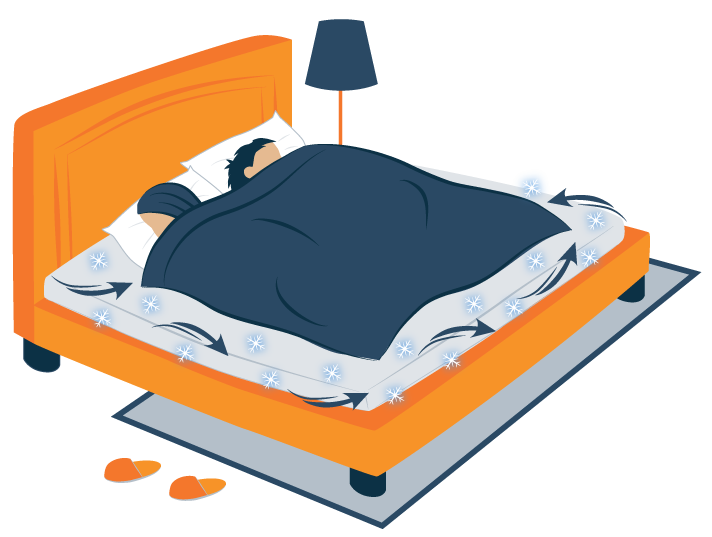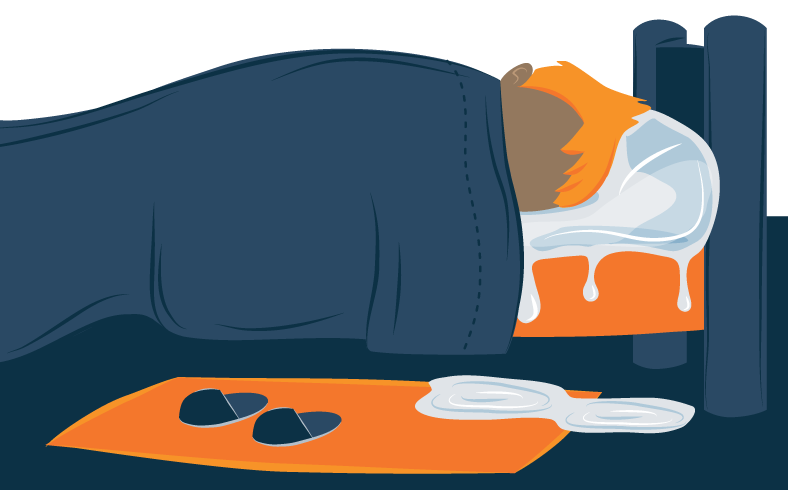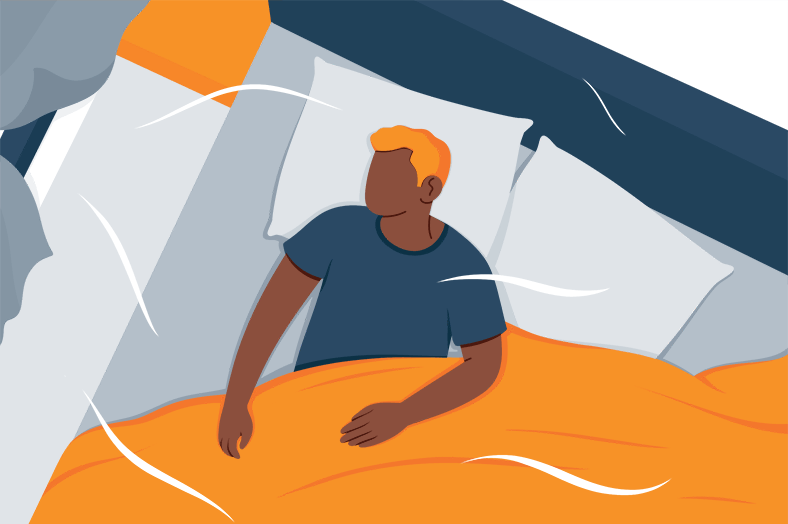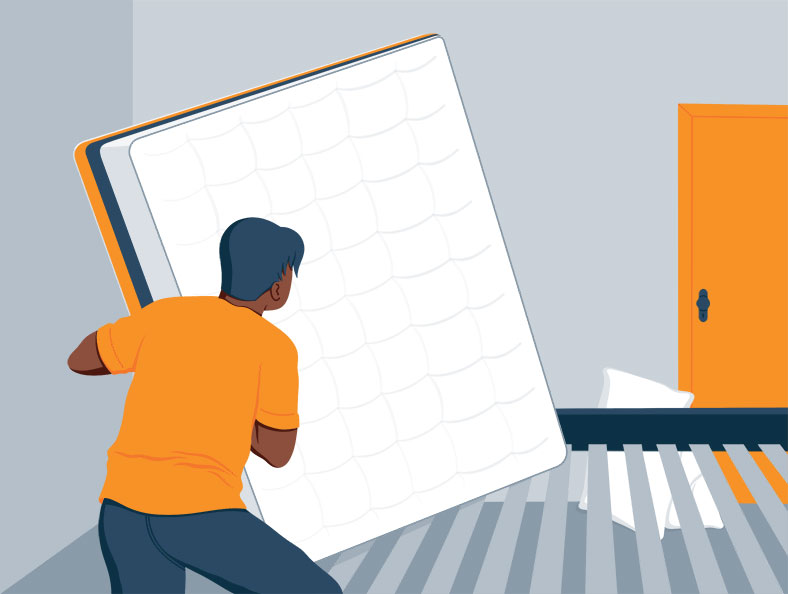Although memory foam has many advantages, a top complaint of this material is that it retains heat or sleeps warm, resulting in restless and sweaty nights. As a result, your sleep quality can deteriorate, affecting your physical and mental well-being.
If you’re someone who loves memory foam but wants to avoid overheating, you’re probably wondering how to make it cooler so that you can enjoy the incredible contouring and pain relief properties of this material.
Stick with us and find out how to cool down your memory foam mattress for better rest.
Why Does Memory Foam Sleep Hot?
One of the negative aspects of memory foam is excessive heat retention due to increased sinkage and “hug.” This can result in sweating and discomfort during sleep.
The reason heat gets trapped inside the foam is because of its unique structure. Memory foam is porous and filled with tiny bubbly spaces. However, it isn’t interconnected to allow a greater amount of airflow inside.
The weight of the body compresses and displaces these tiny bubbles of air. This means that there is no more space for it to circulate. Considering how important this problem is, manufacturers have created specialized cooling mattresses in which temperature-regulating features are added to memory foam beds to help make them sleep cooler.
How to Cool a Memory Foam Mattress
In some cases, you may not be ready to invest in a memory foam bed with cooling capabilities, but the good news is there are additional ways to foster a more temperature-neutral sleep environment. After all, buying a new mattress can be expensive, and if your current mattress is working well for you in all areas except for temperature, it would be a shame to replace it.
Some of these tips are more structural, like adjusting the foundation of your bed, whereas others involve adding new materials, like a cooling topper or new bedding.
Adjust the Foundation
You cannot change the airflow of memory foam as its structure is solid. However, you can make sure that the surface beneath the mattress has plenty of open space where air can move.
Air can get trapped under your mattress and keep your body heat accumulating. This will increase discomfort1 during the time you are supposed to relax. The best beds for proper air circulation have equally spaced wooden boards, which provide lots of room for the air to move around.
If your bed has one sheath of solid plywood, this could increase heat accumulation.
The best advice is to replace your bed’s underside with wooden boards with lots of room to spare. If your bed cannot be modified, exchange it for a model that will allow good airflow underneath. Excessive body heat will soften your memory foam mattress and induce more discomfort. However, providing more airflow underneath can help the bed keep its shape and provide your body with equally displaced surface area support.

Use a Cooling Mattress Topper or Pad
Mattress toppers and pads are used to provide added comfort. These are placed on top of the mattress and underneath the sheets. If heat retention is a problem, cooling mattress toppers could not only deliver more cushioning or support but also enhanced temperature regulation. As for the material, we highly recommend that you opt for a topper made from gel foam, down alternative, or natural cotton.
If your bed is too soft for your taste you can grab a firm mattress topper for extra support and breathability since the rigid materials should keep you more on top of the layers. Mattress toppers are a fantastic budget-friendly alternative if you want to use your bed for couple more years before choosing a new one.

Cooler Bed Sheets
Perhaps a simpler way to cool down your mattress is to replace your current sheets with cooler ones. Cooling sheets are designed to wick away moisture and heat from your body. They’re usually made from high-quality, lightweight materials.
Some of the best materials for cooling sheets include Egyptian cotton, Pima cotton, Supima cotton, bamboo, Tencel, and polyester.
Also, be on the lookout for thread count. Ordinarily, we think the higher the thread count, the better, but when it comes to cooling sheets, that’s not necessarily the case. High thread count sheets are more tightly woven and therefore, will retain more heat. Conversely, certain types of weaves are more breathable and cooling. For example, sateen and jersey weaves tend to be more breathable than, say, a percale weave.
Cooler Pillows
Your head is one of the most important parts of your body in regulating temperature, so it makes sense that buying a cooler pillow would help you cool off overall. However, like mattresses or sheets, some pillows naturally retain more heat than others.
A cooling pillow is made specifically to regulate your temperature, using different materials, casings, and designs than regular pillows. Some of these pillows may contain memory foam as well, but they counteract heat retention by adding cooling gels or shredded foam that’s more breathable.

More Ways to Help You Sleep Cool
- Lower the Thermostat – Experts recommend sleeping in a cool room that is between 60-68 degrees at night. This will help tell your body it’s time to produce melatonin, the hormone that signals your body to sleep.
- Open the Window – If it’s cool where you live and you don’t want to crank the AC, you can always open a window. You can also open two windows across from each other, or put a fan in front of your window, to create a cross breeze.
- Wear Breathable Pajamas – Pajamas made out of cotton, linen, or bamboo are going to be the most breathable. Avoid flannel or wool pajamas if you’re trying to keep cool at night.
- Turn Off the Lights – The energy from lighting adds a surprising amount of heat to a room, so be sure to turn off the lights during the day when you can use natural lighting and keep them off at night. At night, trying to use use candlelight or just one lamp. This will help keep your space cooler.

When Should I Get a New Mattress?
Memory foam mattresses tend to have a lifespan of about 7-10 years, but this will depend on the quality of the bed and how well you maintain it. So, if your memory foam mattress is approaching its expiration date, it might be about time to get a new one. This is especially true if it’s no longer supportive enough to ensure your spine is well-aligned.
If you’re ready for a new bed, you might want to think about getting a cooler mattress type. Yes, you can take the steps to cool off your mattress, but if you have to get a new one anyway, other mattress types are designed to be cooler in the first place.
Latex, innerspring, and hybrid mattresses all sleep cooler than memory foam mattresses because they naturally have more airflow. That being said, many companies are improving memory foam beds by implementing cooling gels and other breathable materials, so you don’t necessarily have to rule out a memory foam option altogether if that’s your favorite style of mattress. If that’s the case, actively seek out memory foam beds with these features included.

Frequently Asked Questions
Why do I get so hot when I sleep?
When we’re sleeping, our body’s core temperature drops by a couple of degrees. This extra heat has to go somewhere, so it escapes into whatever is surrounding us. If what happens to be surrounding us are insulating materials, the heat will be trapped around us, and we’ll likely wake feeling hot and sweaty. This is why cooling materials are so important for hot sleepers.
Can memory foam be cooling?
Memory foam mattresses tend to be the warmest type of mattress, but certain companies have taken note and are making cooler memory foam mattresses. Many do this by adding a top comfort layer infused with cooling gel.
Otherwise, you can cool down your memory foam mattress by adjusting the foundation, getting a cooling mattress topper, or making your bedding more cooling.
What’s the best mattress for hot sleepers?
The best mattress mattress for hot sleepers will have temperature-regulating properties included in its construction. Hybrid and innersprings beds offer lots of breathablity because of the airflow from the coils. Latex beds are also great for hot sleepers because latex is more breathable. Although traditional memory foam beds can trap heat, if the foam in infused with cooling gel, they could serve hot sleepers better. A memory foam hybrid offers an excellent solution as well since it contains memory foam but also has the extra airflow from the coils.
What temperature should my bedroom be when I sleep?
Experts recommend keeping your bedroom between 60 – 68 degrees at night for optimal sleep. At these temperatures, your body is prompted to produce melatonin – one of the key hormones responsible for making you sleepy.
Conclusion
If you bought a mattress with traditional and low-end memory foam, you can only do so much. Our advice would be to change your foundation for better airflow underneath or invest in cooling accessories like breathable toppers, sheets, and pillows. If it’s time to buy a new bed altogether, though, look for mattresses built with breathable, temperature-regulating materials. This includes memory foam mattresses with cooling properties.
Resources:
- Williams, Candice. “The Effects of Heat Acclimation Followed by Sleep Deprivation on Perceived Exertion, Thirst, and Thermal Sensations in Exercising Males”. University of Connecticut. https://opencommons.uconn.edu/cgi/viewcontent.cgi?article=1158&context=srhonors_theses. 2010.

Jill Zwarensteyn
Editor
About Author
Jill Zwarensteyn is the Editor for Sleep Advisor and a Certified Sleep Science Coach. She is enthusiastic about providing helpful and engaging information on all things sleep and wellness.
Combination Sleeper